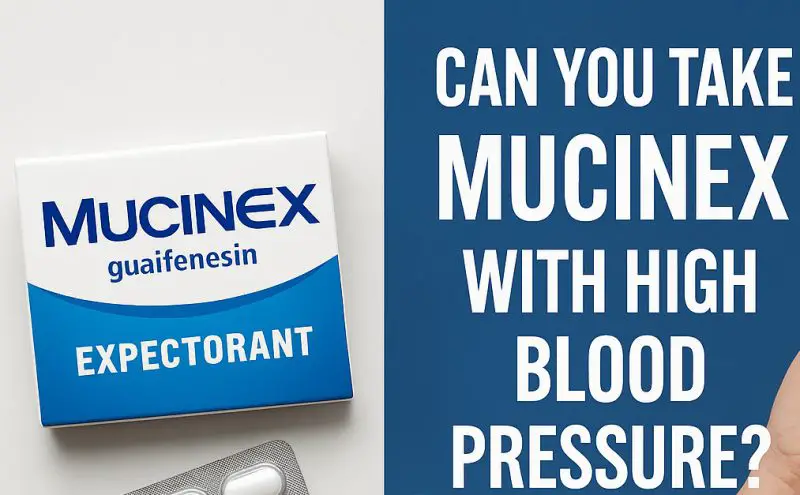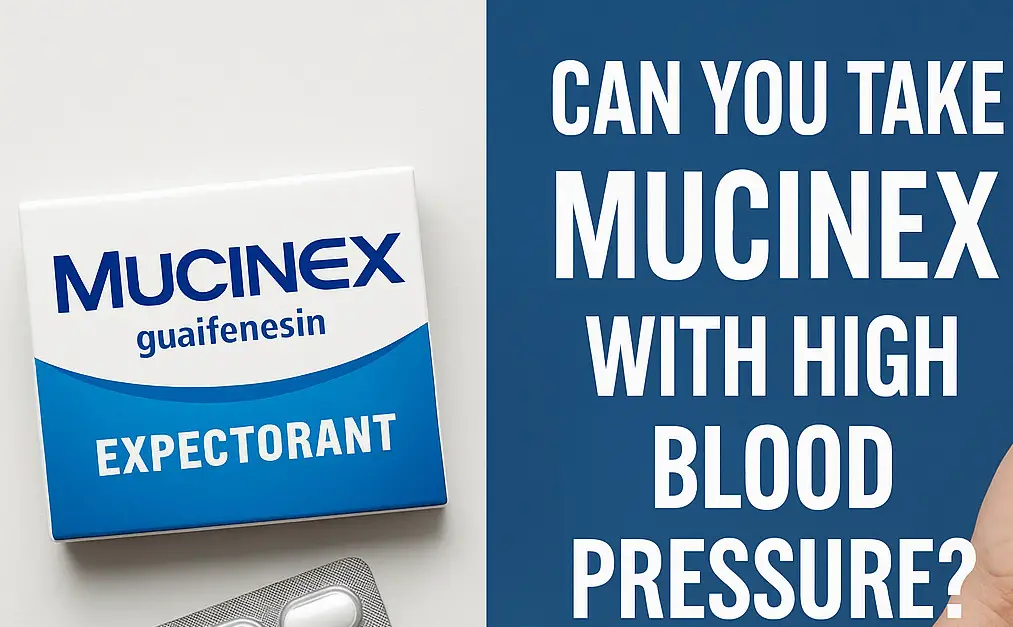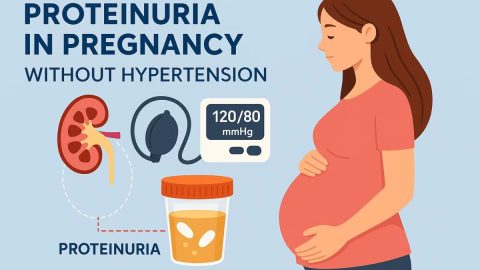Many people rely on Mucinex to ease chest congestion, loosen mucus, and reduce coughing during colds, flu, or seasonal respiratory illnesses. However, when high blood pressure is part of the equation, the simple question “Can you take Mucinex with high blood pressure?” becomes far more complex. Not all Mucinex products are the same, and some contain ingredients that can raise blood pressure or interfere with antihypertensive medications.
For individuals managing hypertension, even over-the-counter medications require careful evaluation. Some cold and flu products contain stimulants that constrict blood vessels, elevate heart rate, or interact with beta-blockers. This makes understanding each active ingredient essential before choosing what seems like a routine remedy. When used incorrectly, these products can worsen hypertension, trigger headaches, or lead to dangerous spikes in blood pressure.
In many cases, patients assume that all Mucinex products are safe because the base ingredient, guaifenesin, does not affect blood pressure. While this is true for “plain Mucinex,” extended-release or combination formulas often contain decongestants such as pseudoephedrine or phenylephrine. These decongestants can significantly raise blood pressure and should be avoided in individuals with uncontrolled hypertension. Knowing the difference can help patients choose safer alternatives and avoid complications.
What Is Mucinex and How Does It Work?

Understanding Guaifenesin and Its Primary Role
Mucinex, in its simplest form, contains guaifenesin, an expectorant designed to loosen and thin mucus in the airways. The medication works by increasing the hydration of secretions in the respiratory tract, allowing them to move more easily and be coughed up without excessive strain. Because guaifenesin does not stimulate the cardiovascular system, it is generally considered safe for individuals with high blood pressure.
When taking guaifenesin alone, most patients experience relief from congestion without any significant systemic effects. The drug does not raise heart rate, constrict blood vessels, or interfere with antihypertensive medications. This makes plain Mucinex an appropriate option for many people diagnosed with chronic hypertension who need relief from chest congestion.
However, the marketplace is filled with multiple Mucinex formulations, and not all of them contain only guaifenesin. Many include additional ingredients for multi-symptom relief. These added components can change the safety profile dramatically, especially for people with cardiovascular concerns. Understanding the exact formulation is the first and most important step in determining whether Mucinex is safe for someone with high blood pressure.
Why Combination Mucinex Products Work Differently
Combination Mucinex products pair guaifenesin with ingredients like decongestants, cough suppressants, pain relievers, or antihistamines. These combinations are convenient for people experiencing several symptoms at once, but they also introduce risks for those who need to avoid cardiovascular stimulation. Decongestants are the most concerning component because they work by narrowing blood vessels in the nasal passages, a process that also affects systemic blood pressure.
In the context of hypertension, even mild vasoconstriction can increase workload on the heart. When combined with certain blood pressure medications such as beta-blockers, these effects can become unpredictable. This is why understanding whether a Mucinex formula contains pseudoephedrine or phenylephrine is crucial before use. Packaging labels can be confusing, leading many patients to take products unsuited for their condition.
The safest approach for hypertensive patients is to choose single-ingredient guaifenesin unless a healthcare professional recommends otherwise. This minimizes interactions, reduces cardiovascular strain, and helps ensure consistent blood pressure control during respiratory illnesses.
The Importance of Reading Labels Carefully
Because Mucinex products are widely available, many consumers purchase them quickly, assuming all variants serve the same function. However, packaging often highlights symptom relief rather than detailing cardiovascular impact. Terms like “Max Strength,” “D,” or “Multi-Symptom” usually indicate the presence of additional ingredients, including decongestants that can raise blood pressure.
People managing hypertension must check the “Active Ingredients” panel rather than relying on front-label phrases. Even small doses of decongestants can cause significant increases in blood pressure in sensitive individuals. Those who take antihypertensive medications may experience reduced medication effectiveness when stimulants are present in the bloodstream.
Accurate label reading is essential for avoiding unintentional exposure to blood pressure-elevating substances. When in doubt, choosing the simplest formulation or consulting a pharmacist can help prevent complications.
Which Mucinex Products Are Safe for High Blood Pressure?
Why Plain Mucinex Is Usually Considered Safe
Plain Mucinex, which contains only guaifenesin, does not affect heart rate or blood vessel constriction. This makes it the safest option for individuals with high blood pressure. The medication’s primary role is to loosen mucus, making coughing more productive and reducing chest congestion. For most hypertensive patients, this effect does not interfere with cardiovascular stability.
Because its mechanism of action is localized to the respiratory system and mucus hydration, guaifenesin remains one of the few cold-related medications that hypertensive individuals can take without significant concern. That said, patient responses can vary based on underlying conditions, other medications, and overall health status. Consulting a healthcare provider ensures that plain Mucinex aligns safely with a patient’s current treatment plan.
This formulation can be taken alongside common blood pressure medications such as ACE inhibitors, beta-blockers, calcium channel blockers, and diuretics. Unlike decongestants, guaifenesin does not counteract the mechanisms of antihypertensive drugs. This makes it a consistent and reliable choice during respiratory illness episodes.
Why Mucinex DM Requires Caution
Mucinex DM combines guaifenesin with dextromethorphan, a cough suppressant. While dextromethorphan does not raise blood pressure directly, it may cause dizziness, drowsiness, or interactions when used with certain medications like MAO inhibitors or some antidepressants. For hypertensive patients, the cardiovascular risk from Mucinex DM is relatively small, but indirect effects still warrant attention.
The primary concern with Mucinex DM is the potential for neurological or sedative effects, which may complicate monitoring of blood pressure symptoms. For instance, dizziness or confusion can be mistaken for signs of uncontrolled hypertension, making it harder for patients to determine whether the issue is medication-related or cardiovascular. This complicates self-assessment during illness.
Although Mucinex DM is generally safer than decongestant-containing versions, it is still crucial for hypertensive individuals to understand their unique medication interactions. A healthcare provider can confirm whether Mucinex DM is appropriate, especially in cases where the patient uses multiple long-term medications.
When Mucinex “D” Should Be Avoided
Mucinex D contains pseudoephedrine, a potent decongestant known to raise blood pressure and heart rate. Pseudoephedrine constricts blood vessels throughout the body, which can quickly elevate blood pressure levels. For individuals already diagnosed with hypertension, especially uncontrolled hypertension, this effect can lead to headaches, palpitations, or hypertensive emergencies.
Even in controlled hypertension, pseudoephedrine can interfere with the effectiveness of antihypertensive medications, reducing their impact and causing sudden spikes in blood pressure. Patients taking beta-blockers face a unique risk because pseudoephedrine’s stimulant effects may overpower the medication, leading to cardiovascular instability.
Hypertensive individuals should avoid any medication labeled with “D,” “Decongestant,” or “Sinus Relief” unless explicitly approved by a healthcare provider. These formulations pose the highest cardiovascular risk among all Mucinex products. Choosing guaifenesin-only formulations remains the safer and more predictable choice.
How Decongestants Affect Blood Pressure
The Mechanism Behind Blood Pressure Elevation
Decongestants like pseudoephedrine and phenylephrine relieve nasal congestion by constricting blood vessels in the nasal passages. However, this vasoconstriction is not limited to the respiratory system. These medications cause systemic vasoconstriction, tightening blood vessels throughout the body and increasing resistance on the heart.
For individuals with hypertension, this added resistance can raise blood pressure significantly. The cardiovascular system is already working harder to maintain stable pressure, and stimulants increase this workload. Patients often notice symptoms such as rapid heartbeat, restlessness, or elevated systolic readings within hours of taking decongestants.
These short-term spikes may seem harmless, but repeated exposure or underlying cardiovascular weakness can lead to severe complications. This is why medical professionals strongly advise against using decongestants in people whose blood pressure is uncontrolled or poorly monitored.
Interactions With Antihypertensive Medications
Decongestants can also interfere with the effectiveness of blood pressure medications. Beta-blockers, for example, work by relaxing blood vessels and reducing heart rate. Decongestants counteract these effects by tightening vessels and stimulating the heart, creating an internal conflict that destabilizes blood pressure regulation.
Patients taking ACE inhibitors or ARBs may also notice less control over their blood pressure when decongestants are present in the system. Because decongestants cause systemic stimulation, they reduce the vasodilating effects of antihypertensive drugs. This can lead to fluctuations that require medication adjustments or closer monitoring.
Understanding these interactions is critical for avoiding setbacks in hypertension management. Even a single dose of a decongestant can destabilize blood pressure for days in sensitive individuals.
Why Some People Experience Stronger Reactions
People react differently to decongestants based on genetics, medication combinations, age, and cardiovascular health. Older adults and individuals with chronic hypertension tend to experience stronger reactions because their blood vessels are already less flexible. The stimulant effect exaggerates pressure changes, increasing cardiovascular stress.
Some individuals metabolize stimulants more slowly, causing prolonged elevation in heart rate and blood pressure. Others may experience anxiety or restlessness, making it difficult to distinguish medication reactions from hypertension symptoms. This variability makes self-medicating with decongestants particularly risky for people with blood pressure concerns.
Because reactions can be unpredictable, most clinicians recommend avoiding decongestant medications entirely unless absolutely necessary and medically supervised.
Safer Alternatives for People With High Blood Pressure
Using Saline Sprays and Nasal Rinses
Saline nasal sprays are one of the safest and most effective alternatives for individuals with hypertension. They work by moisturizing nasal passages, reducing inflammation, and clearing mucus without influencing blood pressure or interacting with medications. Because they do not contain stimulants, they can be used multiple times a day without cardiovascular risk.
Nasal irrigation systems such as neti pots also help relieve congestion by physically flushing out irritants and excess mucus. This mechanical approach bypasses the cardiovascular system entirely, making it suitable for individuals who cannot tolerate medication-based remedies. When performed correctly with sterile or distilled water, nasal rinsing offers significant relief during cold and flu symptoms.
These saline-based options are particularly helpful at night when nasal congestion disrupts breathing and sleep. They support the body’s natural healing process while maintaining cardiovascular stability.
Choosing Antihistamines Carefully
Some antihistamines can be used safely by individuals with high blood pressure, while others should be avoided due to stimulant effects. Non-sedating antihistamines like cetirizine and loratadine generally do not raise blood pressure and can help relieve allergies or mild congestion. They reduce inflammation in the nasal passages without stimulating the cardiovascular system.
However, antihistamines labeled with “D” contain decongestants and should be avoided for the same reasons as Mucinex D. These formulations pose cardiovascular risks because they include pseudoephedrine or phenylephrine. Patients must check ingredient lists carefully to ensure they are choosing safe alternatives.
When used appropriately, antihistamines can complement other non-stimulant remedies and provide well-rounded relief for hypertensive individuals experiencing cold or allergy symptoms.
Natural Methods to Support Airway Comfort
Steam inhalation, warm showers, and humidifiers are helpful for loosening mucus and relieving nasal congestion without affecting blood pressure. Steam helps hydrate airways, making mucus easier to expel while easing coughing and throat irritation. Humidifiers add moisture to indoor air, reducing dryness that exacerbates congestion.
Hydration is also a critical natural remedy. Drinking warm fluids helps thin mucus from the inside, supporting the action of expectorants like guaifenesin. Warm teas with honey provide additional soothing effects without causing cardiovascular stimulation.
These natural interventions work particularly well when combined with plain Mucinex, offering multi-layered support during respiratory illness while maintaining safe blood pressure levels.
When to Seek Medical Advice
Recognizing Signs of Unsafe Blood Pressure Changes
Individuals taking any cold or flu medication must be aware of signs indicating unsafe blood pressure elevations. Symptoms may include pounding headaches, chest tightness, blurred vision, or unusual fatigue. When these symptoms appear shortly after taking a medication, it may signal a dangerous cardiovascular response.
Patients with hypertension should monitor their blood pressure more frequently during illness. Respiratory infections can naturally increase stress on the cardiovascular system, and medications may compound these effects. Sudden or dramatic increases in readings should not be ignored, especially if accompanied by dizziness or shortness of breath.
Early recognition allows individuals to seek medical attention before complications escalate. Timely intervention reduces risks and ensures that both hypertension and respiratory symptoms can be managed safely.
Why Healthcare Providers Offer Personalized Guidance
Every individual with high blood pressure has a unique health profile based on medication combinations, comorbidities, age, and cardiovascular sensitivity. Because of this, a medication that is safe for one person may be unsafe for another. Healthcare providers consider all of these variables before recommending Mucinex or alternatives.
Patients managing multiple chronic conditions need especially tailored guidance. Kidney disease, heart failure, and arrhythmias can all affect how the body responds to cold medications. Physicians can recommend formulations that align well with a patient’s existing regimen and provide better control of symptoms without risking blood pressure spikes.
Consulting a provider also helps identify hidden medication interactions and ensures that patients do not inadvertently take stimulant-based remedies. Professional guidance is essential for maintaining safety during periods of illness.
Understanding When Emergency Care Is Needed
In rare but serious cases, decongestant-induced spikes in blood pressure can trigger hypertensive urgency or emergency. Individuals experiencing severe chest pain, confusion, difficulty breathing, or neurological symptoms should seek immediate medical care. These signs may indicate acute cardiovascular distress requiring urgent treatment.
Emergency departments can quickly stabilize blood pressure and address underlying medication reactions. Delaying treatment can increase the risk of stroke, heart attack, or kidney damage. These severe complications are more likely in individuals using decongestants while having uncontrolled hypertension.
Recognizing when symptoms require immediate intervention empowers patients to act quickly and protect their long-term health.
FAQs About Taking Mucinex With High Blood Pressure
Is plain Mucinex safe for high blood pressure?
Yes. Plain Mucinex containing only guaifenesin does not raise blood pressure and is generally safe for individuals with hypertension.
Why is Mucinex D unsafe for people with high blood pressure?
Mucinex D includes pseudoephedrine, a decongestant that constricts blood vessels and increases blood pressure, making it risky for hypertensive patients.
Can Mucinex DM raise blood pressure?
Mucinex DM does not directly raise blood pressure, but its cough suppressant ingredient can interact with other medications, so caution is advised.
Can I take Mucinex if I am on blood pressure medication?
You can take plain Mucinex, but avoid stimulant-containing formulas. Always check labels and consult a healthcare provider.
Does phenylephrine increase blood pressure?
Yes. Phenylephrine, commonly found in cold medicines, can raise blood pressure because it causes vasoconstriction.
What should I take for congestion if I have high blood pressure?
Saline sprays, steam inhalation, humidifiers, and plain guaifenesin are safer alternatives.
Can decongestants interfere with blood pressure medications?
Decongestants can counteract antihypertensive drugs, reducing their effectiveness and causing blood pressure spikes.
How can I tell if a medication contains a decongestant?
Look for labels showing “D,” “Decongestant,” “Sinus,” or ingredients like pseudoephedrine or phenylephrine.
Conclusion
People with high blood pressure must be cautious when choosing over-the-counter cold and flu medications. While plain Mucinex containing guaifenesin is generally safe, combination products such as Mucinex D pose significant risks due to their decongestant ingredients. Understanding how these medications affect cardiovascular function allows patients to make safer, more informed decisions. When uncertainty arises, consulting a healthcare provider ensures appropriate and effective symptom relief without compromising blood pressure control.
Disclaimer: This article is for educational purposes only and is not medical advice. Always consult a licensed healthcare professional before taking any medication, especially if you have high blood pressure or other chronic conditions.



